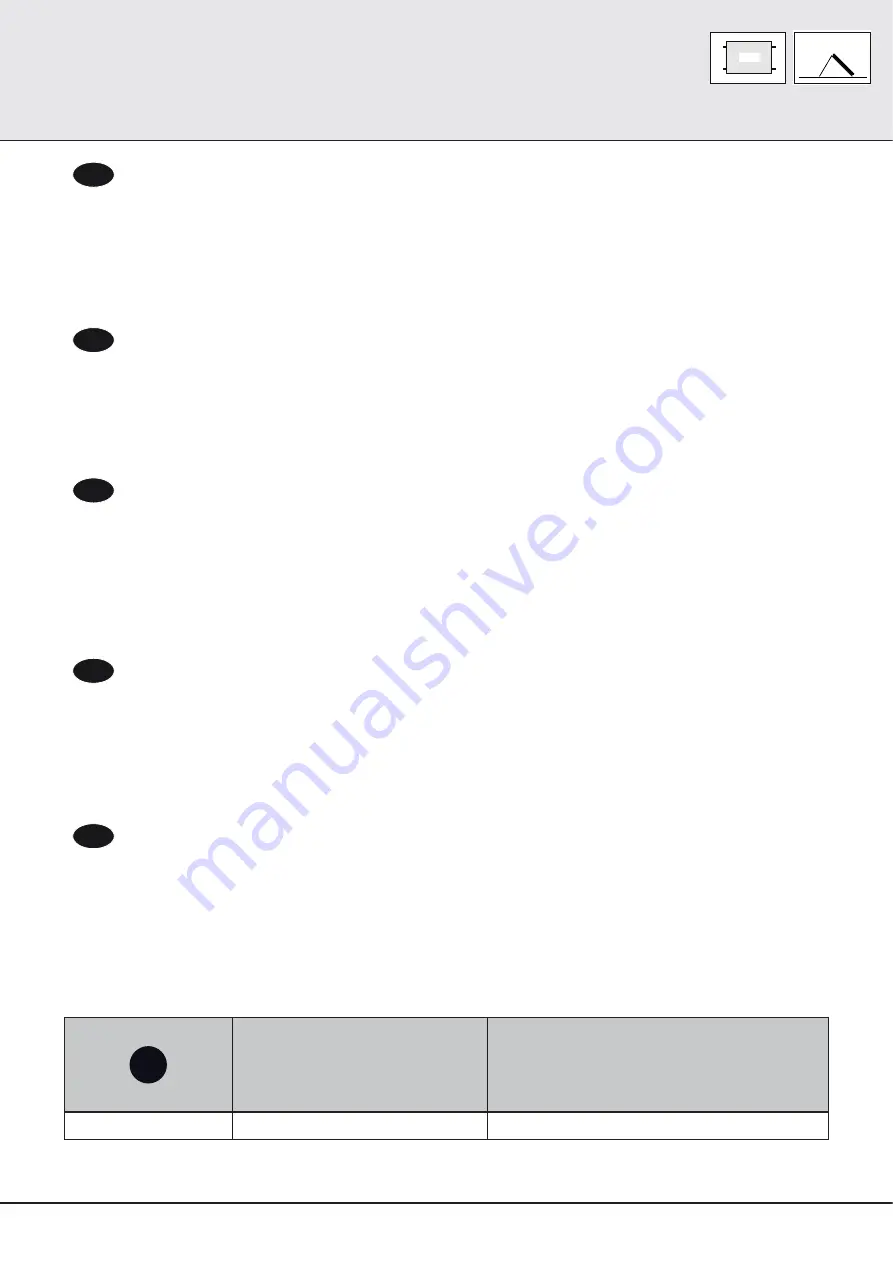
34
35-50°
2,5m²
Empfehlung für Befestigungspunkte
Recommendation for attachment points
5DFFRPDQGD]LRQHSHULSXQWLGL¿VVDJJLR
5HFRPPDQGDWLRQFRQFHUQDQWOHVSRLQWVGH¿[DWLRQ
5HFRPHQGDFLRQHVSDUDORVSXQWRVGH¿MDFLyQ
DE
Statikangaben Betonballastkörper (STANDARD LOAD)
Die maximal zulässigen Windlasten für die Kollektoren sind den Montagehinweisen zu entnehmen. Im Fall
einer Freiaufständerung ist als Sicherheit gegen Kippen und Gleiten der Einsatz von Betonballastkörpern
vorgesehen. Die Mindestgewichte der Betonballastkörper in Abhängigkeit der angreifenden Böengeschwin-
GLJNHLWVLQGDXVGHUQDFKIROJHQGHQ7DEHOOH]XHQWQHKPHQ-H6WW]HEHQHLVWHLQLQGHU6WW]HEHQHGXUFK
gehender Betonballastkörper mit einer Mindestlänge zu verwenden. Zwischen Betonballastkörper und Auf-
VWHOOÀlFKHVLQGUXWVFKKHPPHQGH*XPPLXQWHUODJVPDWWHQ]XYHUZHQGHQ$XI*UXQGGHUKRKHQ*HZLFKWH
der Betonballastkörper ist die Tragfähigkeit des Daches auf ihre Eignung unter Beiziehung eines Statikers
und Berücksichtigung möglicherweise auftretender Zusatzlasten (z. B. Schneelasten) einer Überprüfung
]X]XIKUHQ'LHVHVWDWLVFKHQ$QJDEHQVLQGQDFK(1GH¿QLHUW
EN
Structural data for concrete ballasts (STANDARD LOAD)
The maximum permissible wind load for the collectors can be found in the mounting instructions. For
ground-mounted installations, concrete ballasts are required to prevent the structure from sliding or
tipping over. The minimum weight of the concrete ballasts in relation to the potential gust speed can be
found in the following table. Each supporting plane requires one continuous piece of concrete ballast with
a minimum length. Slip-resistant rubber matting must be placed between the concrete ballast and the in-
stallation surface. Due to the heavy weight of the concrete ballasts, an evaluation must be undertaken by
a structural engineer to check the load-bearing capacity of the roof and its suitability to handle possible
DGGLWLRQDOZHLJKWHJVQRZ7KHVWDWLFDOUHTXLUHPHQWVKDYHEHHQGH¿QHGDFFRUGLQJWR(1
IT
Valori statici di blocchi zavorra in calcestruzzo (STANDARD LOAD)
Per determinare i valori limite dei carichi da vento consentiti sui collettori, consultare le rispettive istruzi-
oni di montaggio. Nel caso di impianti a terra, è necessario impiegare blocchi zavorra in calcestruzzo per
assicurare l‘impianto contro crolli e spostamenti. Per calcolare il peso minimo dei blocchi zavorra in funzi-
RQHGHOODYHORFLWjGHOOHUDI¿FKHGLYHQWRULIHULUVLDOODWDEHOODVRWWRVWDQWH3HURJQLEDVHGLVRVWHJQRGHYH
essere impiegato un’unico blocco zavorra che occupi l‘intero spazio di sostegno e abbia una determinata
OXQJKH]]DPLQLPD7UDLEORFFKL]DYRUUDHODVXSHU¿FLHGLLQVWDOOD]LRQHGHYRQRHVVHUHLPSLHJDWLWDSSHWLQL
di gomma antiscivolo. A causa del peso elevato dei blocchi zavorra, è necessario rivolgersi a un ingegnere
VWUXWWXUDOHDI¿QFKpYHQJDYHUL¿FDWDODFDSDFLWjGLFDULFRHOµLGRQHLWjGHOWHWWRDWROOHUDUHWDOHVWUXWWXUDHG
HYHQWXDOLFDULFKLDJJLXQWLYLTXDOLSHUHVHPSLRLOFDULFRGDQHYH4XHVWLGDWLVWUXWWXUDOLVRQRGH¿QLWHGDOOD
norma EN 1991.
FR
Informations relatives à la statique des blocs de lest en béton (STANDARD LOAD)
/HVFKDUJHVGHYHQWPD[LPXPDGPLVVLEOHVSRXUOHVFDSWHXUV¿JXUHQWGDQVOHVLQVWUXFWLRQVGHPRQWDJH
'DQVOHFDVG¶XQPRQWDJHVXUFKkVVLVSUpYR\H]GHVEORFVGHOHVWHQEpWRQD¿QG¶pYLWHUTXHOHVFKkVVLV
ne glissent ou ne basculent. Les poids minimum des blocs de lest en béton sont indiqués dans le tableau
ci-dessous selon la vitesse des rafales en présence. Pour chaque surface d’appui, il convient d’utiliser un
seul bloc de lest en béton continu d’une longueur minimum. Utilisez des nattes inférieures en caoutchouc
HQWUHOHVEORFVGHOHVWHQEpWRQHWODVXUIDFHGHPRQWDJHD¿QG¶pYLWHUWRXWJOLVVHPHQW(QUDLVRQGXSRLGV
pOHYpGHVEORFVGHOHVWHQEpWRQYpUL¿H]O¶DSWLWXGHGHODSRUWDQFHGXWRLWHQIDLVDQWDSSHOjXQH[SHUWHQ
statique et en tenant compte des charges supplémentaires éventuelles (par ex. charges de neige). Ces
GRQQpHVWHFFKQLTXHVVRQWGp¿QLHVVHORQODQRUPH(1
ES
Datos relativos a la estática de los cuerpos de carga de hormigón (STANDARD LOAD)
Las cargas de viento máximas permitidas para los colectores pueden consultarse en las instrucciones de
montaje. En caso de montaje libre sobre soporte, se prevé la instalación de cuerpos de carga de hormi-
gón como medida de seguridad para evitar que los colectores puedan volcar o resbalar. El peso mínimo de
dichos cuerpos de hormigón, que dependerá de la velocidad de las ráfagas de viento que incidan sobre los
FROHFWRUHVGHEHFRQVXOWDUVHHQODVLJXLHQWHWDEOD3DUDFDGDVXSHU¿FLHGHDSR\RGHEHUiXWLOL]DUVHXQVROR
FXHUSRGHFDUJDFRQXQDORQJLWXGPtQLPD(QWUHHOFXHUSRGHFDUJD\ODVXSHU¿FLHGHPRQWDMHGHEHUiQ
colocarse esteras de goma antideslizamiento. Debido al alto peso de los cuerpos de carga, deberá some-
WHUVHHOWHMDGRDXQH[DPHQSRUSDUWHGHXQLQJHQLHURGHHVWiWLFDSDUDFHUWL¿FDUVXDGHFXDFLyQWHQLHQGR
en cuenta todas las cargas adicionales que puedan producirse (p. ej. cargas de nieve). Estas dimensiones
HVWiWLFDVHVWDQGH¿QLGDVVHJXQ(1
i
Böengeschwindigkeit [ km/h ]
gust of wind [km/h]
vento massima [km/h]
vents maximales [km/h]
viento de max. [km/h
Charakteristische Schneelast [ kN/m² ]
characteristic snow load [kN/m²]
carico di neve caratteristica [kN/m²]
poids de neige charactéristique [kN/m²]
carga caracterísitica de nieve [kN/m²]
35 - 50°
133 (q =0,85 kN/m²)
2,0
















































